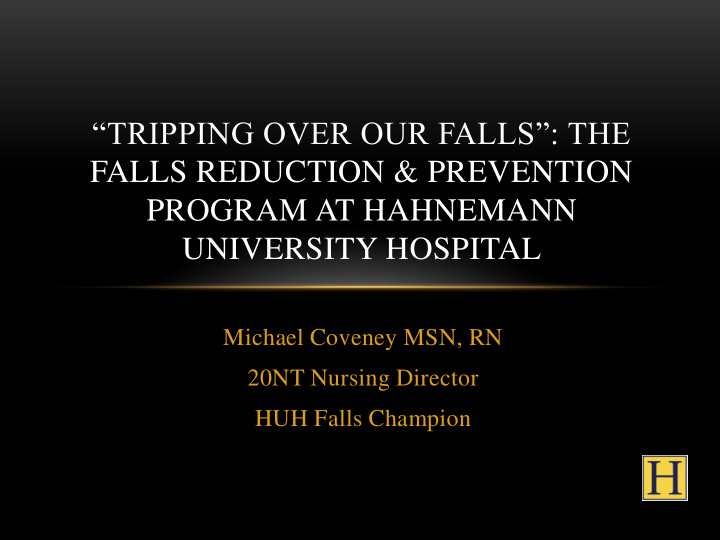



“TRIPPING OVER OUR FALLS”: THE FALLS REDUCTION & PREVENTION PROGRAM AT HAHNEMANN UNIVERSITY HOSPITAL Michael Coveney MSN, RN 20NT Nursing Director HUH Falls Champion
FALL PREVENTION RELEVANCE Governing Factors Fact • Center for Medicare & Fall are most commonly Medicaid Services reported safety event reported • The Joint Commission among hospitalized patients • National Quality Forum & most common adverse • NDNQI effect reported in facilities. • State Authorities • Pennsylvania State Reporting System Titler, 2011; Rush, 2008
NURSING’S DUTY TO PREVENT HARM • Code of ethics • Standards of nursing practice • Falls are leading cause of injury related death in adults 65 and older • Adults aged 75 and older are 4 times more likely to experience fall with injury than someone 65 to 74.
PATIENT EXPERIENCE WITH FALLS • Embarrassment • Added medical treatments • Fear of recurrent fall • Fractures & Injuries • Loss of mobility • Increased length of stay (LOS) in acute care facilities • Admission to Long-Term Care Facility post hospitalization
STAFF NURSE EXPERIENCE • Guilt, Anxiety, & Self-blame • Failure to keep patient free from harm • Increased Workload and Resources • Increase LOS: 6.27 days • Financial Implication: • $13,316 • Legal Implications
CURRENT KNOWLEDGE • Current Research Multiple Fall Assessment Tools • • Falls Definitions Nursing Interventions • • Ambiguity of reporting falls
Cognitive Impairment Treatment s Medications Falls Environment Mobility Limitations Elimination Management
S.W.O.T. ANALYSIS Strengths: Weaknesses: Reporting Process Standard Follow-up Care Delivery Model Awareness Administrative Support Formalization Corporate Support IS Involvement Interdisciplinary Support Opportunities: Threats: Education Over-Reporting Policy Revision Costs Committee Development Patient Safety Benchmarking Fear of Reporting State Involvement “Fall Fatigue”
FALLS PREVENTION COMMITTEE DEVELOPMENT S.W.O.T Evidence- Based Practice Falls Prevention Committee
COMMITTEE ELEMENTS • Consistency • Analytical • Accountability • Creative • Progressive • Goal Oriented • Multi-disciplinary
FALL COMMITTEE ACTIONS • Weekly meetings • Fall Alert Team • Post Fall Investigation • Unit-based Fall Trending • Unit-based Fall Champions • Outpatient Setting Involvement • PA Hospital Engagement Network (HEN) Project • National Falls Awareness Day
FALLS COMMITTEE ACTIONS • Equipment • BSC with transfer benches • Moblility Alarms • Beds • Low to ground • Built-in alarms • Technology • CPOE high risk meds • IMPACT Project • Products • Short gown trials • Stationary furniture
PREVENTION STRATEGIES • Utilize bed alarms when appropriate • Safety Huddles every shift • Bed alarms with every patient falling within 3 mos. • Recognize Common Risk Factors • Tailor prevention strategies to each individual patient. • Be proactive, not reactive • Round on patients PEP Rounds (Pain, Elimination, Position) • • Remain with patients while Q2 hours • toileting No Pass Zone • • Family Education • E-Learning competency
HUH FALL RATE TRENDS Fall Rate 4.5 4 3.5 3 2.5 Fall Committee 2 1.5 1 0.5 0 Jan-11 Feb Mar Apr May Jun Jul Aug Sep Oct Nov Dec Jan-12 Feb Mar Apr May Jun Jul Aug Sep Oct Nov Dec
CONCLUSION • Literature • Patient centered prevention measures • Skill Mix • Governing Healthcare Agencies • ANCC & Magnet • CMS • AHRQ • Gap Analysis • Organizational Awareness
NATIONAL FALLS AWARENESS DAY
REFERENCES Feil, M. & Gardner, L.A. (2012). Fall risk assessment: a foundational element of falls prevention program. PA Patient Safety Advisory, 9(3), 73-81. Rush, K.L., Robey-Williams, C., Patton L.M., Chamberlain, D., Bendyk , H., & Sparks, T. (2008). Patient falls: acute care nurses’ experiences. Journal of Clinical Nursing, 18, 257-365. Titler, M.G., Shever, L.L., Kanak, M.F., Picone, D.M., & Quin, R. (2011). Factors associated with falls during hospitalization in an older adult population. Research and Theory for Nursing Practice, 25(2), 127-152. When the patient falls out of bed, who pays? (2009). Bulletin World Health Organization, 87, 169-170.
Recommend
More recommend